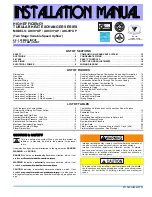
To remove bottom closure panel, perform following:
1. Tilt or raise furnace and remove 2 screws holding front filler
panel. (See Fig. 29.)
2. Rotate front filler panel downward to release holding tabs.
3. Remove bottom closure panel.
4. Reinstall front filler panel and screws.
Step 7—Gas Piping
Gas piping must be installed in accordance with national and local
codes. Refer to NFGC in the U.S. Canadian installations must be
made in accordance with NSCNGPIC and all authorities having
jurisdiction. Gas supply line should be a separate line running
directly from meter to furnace, if possible. Refer to Table 5 for
recommended gas pipe sizing. Risers must be used to connect to
furnace and to meter. Support all gas piping with appropriate
straps, hangers, etc. Use a minimum of 1 hanger every 6 ft. Joint
compound (pipe dope) should be applied sparingly and only to
male threads of joints. Pipe dope must be resistant to propane gas.
FIRE OR EXPLOSION HAZARD
Failure to follow this warning could result in fire, explosion,
personal injury, or death.
- Connect gas pipe to furnace using a backup wrench to avoid
damaging gas controls.
- Gas valve shutoff switch MUST be facing forward or tilted
upward.
- Never purge a gas line into a combustion chamber. Never
test for gas leaks with an open flame. Use a commercially
available soap solution made specifically for the detection
of leaks to check all connections.
- Use proper length of pipe to avoid stress on gas control
manifold.
- If a flexible connector is required or allowed by authority
having jurisdiction, black iron pipe shall be installed at
furnace gas valve and extend a minimum of 2 in. outside
furnace casing.
-Protect gas valve from water and debris. Gas valve inlet
and/or inlet piping must remain capped until gas supply line
is permanently installed to protect the valve from moisture
and debris. Also, install a sediment trap in the gas supply
piping at the inlet to the gas valve.
Install a sediment trap in riser leading to furnace. Trap can be
installed by connecting a tee to riser leading to furnace so
straight-through section of tee is vertical. Then connect a capped
nipple into lower end of tee. Capped nipple should extend below
level of gas controls. Place a ground joint union between gas
control manifold and manual gas shutoff valve. (See Fig. 30.)
An accessible manual shutoff valve MUST be installed external to
furnace casing and within 6 ft of furnace. A 1/8-in. NPT plugged
tapping, accessible for test gauge connection, MUST be installed
immediately upstream of gas supply connection to furnace and
downstream of manual shutoff valve.
Gas line grommet (factory-supplied loose parts bag) should be
used when installing gas piping. Gas line entry hole filler plug
should be installed in unused gas line entry hole. (See Fig. 31.)
NOTE:
The gas valve inlet pressure tap connection is suitable to
use as test gauge connection providing test pressure DOES NOT
exceed maximum 0.5 psig (14-in. wc) stated on gas valve. (See
Fig. 59.)
Piping should be pressure and leak tested in accordance with
NFGC in the United States or NSCNGPIC in Canada, local, and
national plumbing and gas codes before the furnace has been
connected. If pressure exceeds 0.5 psig (14-in. wc), gas supply
pipe must be disconnected from furnace and capped before
pressure test.
If test pressure is equal to or less than 0.5 psig (14-in. wc), turn off
electric shutoff switch located on gas valve before test. It is
recommended that ground joint union be loosened before pressure
testing. After all connections have been made, purge lines and
check for leakage at furnace prior to placing it into service.
The gas supply pressure shall be within the maximum and
minimum inlet supply pressures marked on the rating plate with
the furnace burners ON at HI-HEAT and OFF.
Fig. 29—Removing Bottom Closure Panel
A93047
BOTTOM
CLOSURE
PANEL
FRONT FILLER
PANEL
Table 5—Maximum Capacity of Pipe*
NOMINAL
IRON
PIPE
SIZE
(IN.)
INTERNAL
DIAMETER
(IN.)
LENGTH OF PIPE (FT)
10
20
30
40
50
1/2
0.622
175
120
97
82
73
3/4
0.824
360
250
200
170
151
1
1.049
680
465
375
320
285
1-1/4
1.380
1400
950
770
660
580
1-1/2
1.610
2100
1460
1180
990
900
* Cubic ft of gas per hr for gas pressures of 0.5 psig (14-in. wc) or less, and
a pressure drop of 0.5-in. wc (based on a 0.60 specific gravity gas). Ref:
Table 9-2 NFPA 54-2002.
Fig. 30—Typical Gas Pipe Arrangement
A93324
UNION
SEDIMENT
TRAP
MANUAL
SHUTOFF
VALVE
(REQUIRED)
GAS
SUPPLY
24
→
→
















































